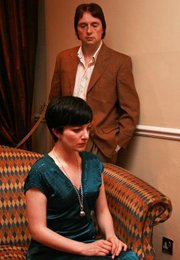First staged in 1994, Marina Carr’s The Mai marks the shift in her oeuvre towards a more mainstream style. This work stages the memories of Millie, the title character’s daughter; the adult Millie narrates the drama performed on stage, but participates in the action as a child, and reconstructs the summer of 1979 (when The Mai’s estranged husband returns after a five-year absence) and the summer of 1980 (when their relationship has disintegrated again).
Newman’s set of large Victorian-style patterns in muted pinks and golds helped to contextualise the play within the late 70s, as well as conveying the opulence of The Mai’s newly built home. The grandeur of the house is significant as it appears to have been erected to compensate for Robert’s absence. Playing Millie, Martyna Lawton showcased her skills as a storyteller; she gently guided the audience through Carr’s sensuously-weaved narrative. The subtle and gradual shifts in James Cummins’ lighting appeared to symbolise the process of recollections clarifying in Millie’s mind. Like Millie’s memories, the lighting alternated between the hazy and the stark.
Similarly, Chalmers’ direction intensified the drama’s juxtaposition of nostalgia and pain, eliciting performances that soared with emotion. Most poignant was the female tenderness she evoked through the movements, gestures and positions of the actors. In a comfortable, familial way, the women stroked each other’s hair, while Maria O’Callaghan (playing Beck) tended to sit curled at the legs of one of the others. Conversely, certain scenes pulsated with deep-set hurt and fury, for example Grandma Froachlan’s argument with her daughter Julie. During these moments Antoinette Hilliard was commendable as the irrational Grandma Froachlan, but was at her best in her hilarious delivery of Grandma’s more comic dialogue. In the role of Julie, Judy Donovan’s performance was perhaps the most passionate and emotive in the production.
 Chalmers also skilfully achieves a level of sympathy for The Mai’s husband Robert – a character who could easily be reduced to an archetypal bad guy. Almost always surrounded by The Mai’s family of women, Robert (Kevin Carroll) at times appeared like a caged animal. Even during his most vehement row with The Mai (Claire Jackson), he turned to find Beck lurking behind him. Carroll was aptly-cast as Robert, portraying convincingly a character whose mild-mannered, well-spoken façade barely obscures his insatiable ego and pretensions.
Chalmers also skilfully achieves a level of sympathy for The Mai’s husband Robert – a character who could easily be reduced to an archetypal bad guy. Almost always surrounded by The Mai’s family of women, Robert (Kevin Carroll) at times appeared like a caged animal. Even during his most vehement row with The Mai (Claire Jackson), he turned to find Beck lurking behind him. Carroll was aptly-cast as Robert, portraying convincingly a character whose mild-mannered, well-spoken façade barely obscures his insatiable ego and pretensions.
Most visually striking were Claire Jackson’s costumes, which stood out vibrantly against Newman’s set. Many of the clothes subtly harmonised with the personalities and stories of the characters that they adorned. A red frill at the end of Grandma’s dress hinted at a Spanish dancer image, thereby conjuring the character’s supposed ancestry. Dressed like a hippy, O’Callaghan wore the vestiges of Beck’s non-conformist liberalism. Finally, The Mai’s blue gown anticipated the attire in which she would go to her grave, a foreboding of her impending death.
These elements demonstrate Chapter’s original take on the drama. Over a decade after the first staging of the play, the production would have benefited from even more of such creative input. That said, the actors, under Chalmer’s astute direction, truly enlivened Carr’s script by embodying naturally this family’s agonising frictions and heart-warming affections.
Siobhán O’Gorman is currently completing a doctoral research project on gender and the canon in contemporary theatre at the National University of Ireland, Galway.